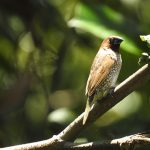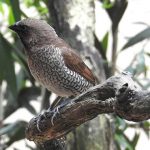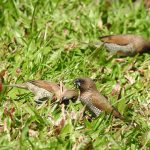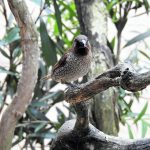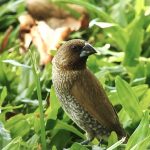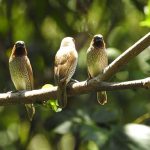SCALY-BREASTED MUNIA
Introduced species
Sharon: These are the tiny Nutmeg Mannikins finches that I have filmed in Northern Queensland Australia. I have seen them in several locations around Cairns when the grasses are seeding. They have some lovely pattern feathers, so if you look closely you will see these.
The Scaly-breasted Munia: A Tale of Adaptation and Impact. Small Bird with a Big Story
Imagine a gentle morning in eastern Australia. The air is crisp, and as the sun stretches over grassy fields, a soft chorus of chirping fills the atmosphere. In the swaying grass below, flocks of tiny, chestnut-brown birds flit and flutter. These are the Scaly-breasted Munias (Lonchura punctulata), also known in the pet trade as the Nutmeg Mannikin—an introduced species whose story is both captivating and cautionary.
Distinctive Features: Beauty in Detail
- Size: Just 10–11 cm long, these birds are diminutive but lively.
- Appearance: Their name comes from the unique, scale-like pattern of white and brown markings across their breast, resembling delicate beadwork.
- Bill: The stout, conical bill is perfectly shaped for cracking seeds—a classic trait among finch-like birds.
- Movement: Agile and acrobatic, they dart through the air in coordinated flocks, their wings rustling softly against the grass.
Social Lives: The Heartbeat of the Flock
Scaly-breasted Munias are rarely seen alone. Their social nature is most apparent when:
- Flocking: Dozens, sometimes hundreds, gather in open grassy areas.
- Vocalisations: Their constant, cheerful chirping forms a lively background hum, especially at dawn and dusk.
- Behaviour: They display remarkable synchrony in flight, weaving intricate patterns above the fields.
Imagine standing among these flocks, feeling the gentle whoosh of wings and hearing the harmonious calls echoing through the air.
Diet and Habitat: Seeds of Change
- Food: Their diet is largely made up of grass seeds and grains. Their small but strong bills can easily break open the toughest husks.
- Habitat: In Australia, they thrive in urban parks, gardens, agricultural fields, and grassy plains. The scent of freshly cut grass and the soft, earthy texture underfoot are often clues to their presence.
Breeding and Survival: Masters of Adaptation
- Reproduction: Munias breed prolifically, often raising several broods in a single season.
- Nesting: Flexible in their choice of home, they build nests in tree hollows, among dense shrubs, or even in nooks of buildings.
Their ability to thrive in diverse environments is impressive, but it also raises important questions about their impact on native species.
Ecological Impact: A Delicate Balance
While their beauty and adaptability are remarkable, the Scaly-breasted Munia’s presence in Australia is not without consequence.
| Positive Aspects | Challenges for Ecosystems |
|---|---|
| Adds diversity to local avifauna | Competes with native birds for food |
| Can be enjoyed by birdwatchers | Potential to disrupt native bird habitats |
| Adaptable to human environments | Sometimes regarded as an agricultural pest |
Their success can come at a cost to native wildlife, as they compete for vital food and nesting resources, sometimes outcompeting smaller, less adaptable native birds.
Conservation Message: Learning from Introduced Species
The story of the Scaly-breasted Munia in Australia is a gentle reminder of the complex relationship between humans, introduced species, and native ecosystems. As we marvel at their beauty and adaptability, it is important to consider the wider consequences:
- Responsible Pet Ownership: Many introductions, including that of the Munia, begin with the pet trade. Responsible choices can help prevent future ecological disruptions.
- Support Local Biodiversity: Protecting native flora and fauna ensures that Australia’s unique ecosystems remain balanced and resilient.
Conclusion: An Ongoing Story
The Scaly-breasted Munia’s journey is still unfolding. Their acrobatic flights and cheerful calls are woven into the tapestry of Australia’s grassy landscapes, offering both delight and a lesson in ecological responsibility. By appreciating their story, we deepen our understanding of nature’s delicate balance and the importance of protecting native wildlife for generations to come.

